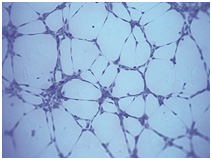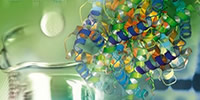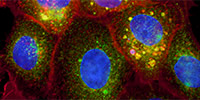Cultrex® Basement Membrane Extract (BME)
Basement membranes are continuous sheets of specialized extracellular matrix that form an interface between endothelial, epithelial, muscle, or neuronal cells and their adjacent stroma. Basement membranes are degraded and regenerated during development and wound repair. They not only support cells and cell layers, but they also play an essential role in tissue organization that affects cell adhesion, migration, proliferation, and differentiation. Basement membranes provide major barriers to invasion by metastatic tumor cells

Specifications
- Endotoxin (LPS) Concentration: ≤ 8 EU/ml
- Source: Murine Engelbreth-Holm-Swarm (EHS) tumor.
- Storage Buffer: Dulbecco’s Modified Eagle’s medium containing 10 mg/ml gentamycin sulfate +/- phenol red.
- Trevgens BME typically ranges in protein concentrations from 14 to 16 mg/ml.
- Storage/Stability: Product is stable for a minimum of 3 months from date of shipment when stored at –20 °C in a manual defrost freezer. For optimal stability, store at –80 °C in aliquots. Keep Frozen; repeated freeze-thaws will destroy product integrity.
Cultrex® Basement Membrane Extract (BME) ** is a soluble form of basement membrane purified from Engelbreth-Holm-Swarm (EHS) tumor. The extract gels at 37°C to form a reconstituted basement membrane. The major components of BME include laminin, collagen IV, entactin, andheparin sulfate proteoglycan. Trevigen's BME typically ranges in protein concentrations from 14 to 16 mg/ml. BME is commonly used to maintain stem and precursor cells in an undifferentiated state during cell culture and BME hydrogels function to induce differentiation of epithelial, endothelial and smooth muscle cells in vitro. BME has also been employed in cell attachment, neurite outgrowth, angiogenesis, and in vitro cell invasion assays.
Cultrex® Stem Cell Qualified Basement Membrane Extract (BME) ** has been shown to provide an effective feeder-free surface for the attachment and maintenance of human embryonic stem cells (hESCs) and induced pluripotent stem cells (iPSCs) in an undifferentiated state, thereby enabling its use for growth promotion or study of stem cell differentiation.
ECM proteins have revolutionized in vitro and in vivo cell models by providing optimal environmental conditions to promote physiologically relevant cellular structure and function. The extracellular matrix (ECM) is the non-cellular environment outside of the cell that directs multicellular organization and provides structural support for tissues. The ECM provides anchorage for cells and connects directly to the cell cytoskeleton through transmembrane receptors. These interactions control vital cell functions, such as proliferation, differentiation, migration, polarity, and survival, and these processes are regulated through modulation of the cell’s epigenetic program and signal transduction cascades. The ECM proteins have been used to:
- Develop several organotypic models using 3-D culture
- To provide barriers
- To evaluate metastatic potential
- To improve cellular implantation and evaluate angiogenesis in vivo
- To maintain stem cells in an undifferentiated state
- To induce stem cell differentiation
** The PathClear® BME designation means that in addition to standard sterility, endotoxin and MAP testing, the BME is tested by PCR and is clear of 31 pathogens and viruses, including lactate dehydrogenase elevating virus (LDEV), which replicates in macrophages. PathClear® BME is available in normal and reduced growth factor form and is ideal for in vivo murine research work and other work requiring BME free from viruses, bacteria and mycoplasma.
**BME is supplied without Phenol Red. Phenol red (catalog # 3430-50-01), provided separately at 100X needs to be added at 1:100 (v/v) prior to use.








